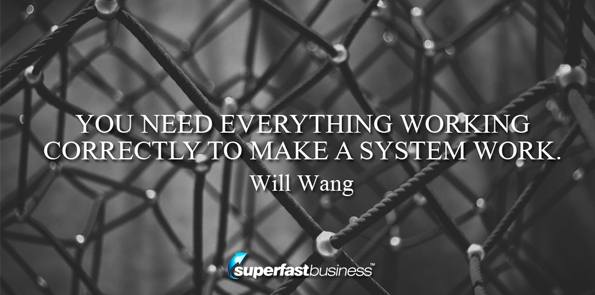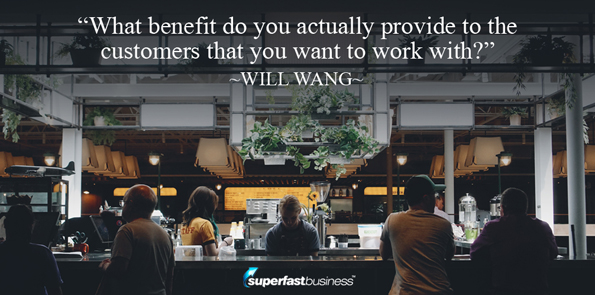Podcast: Download (Duration: 20:16 — 18.7MB)
Get Notified Of Future Episodes Apple Podcasts | Spotify | Amazon Music | Android | Blubrry | Gaana | TuneIn | Deezer | Anghami | RSS | More
Episode highlights:
01:55 – Is email still relevant?
03:42 – Subject lines that work
05:27 – When you don’t have a case study…
06:48 – The use of name-dropping
07:27 – Is it legal?
10:06 – What to put (and not to put) in your emails
16:51 – How do you handle rejection?
18:36 – How many emails to send
Launch marketing campaigns that work with James’s personal coaching
Transcription:
James: James Schramko here. Welcome back to SuperFastBusiness.com. I’m speaking with my special guest Will Wang from GrowthLabz.com. Welcome, Will.
Will: Thanks, James. Special. I like that. Thanks.
James: Yes, you are special. Special enough to be back here on The Get Clients Series. The purpose of this series is to help a business owner understand what’s going on when it comes to cold outreach in particular. This is your super skill. You can generate a whole stash of leads for a business from thin air using special techniques. And we’re talking about these on our episodes.
In the very first episode of this series, which was Episode 610, we sort of covered the concept of getting clients through this outbound marketing channel, how effective it is, which business it’s right for, so you can go and listen to that if you want to get a refresher. This is Episode 613, and today we’re talking about how to use emails for cold outreach. And I think I’ll lead this charge, Will, with, are emails still relevant at the time of recording this in 2018/2019 just around the corner?
Is email still relevant?
Will: Yeah. So that’s actually a really good question. And with fancy things coming out like Facebook ads, Google ads, a lot of people are kind of hearing that emails aren’t working, emails are dead, and it’s always coming around. But the thing is though, we’re finding that emails are actually becoming more and more effective, especially getting into some of the bigger accounts or some of the bigger customers that people are actually looking for.
James: And why do you think that is?
Will: Well, I think the perception is that when people say email is dead, because obviously there’s a lot more people coming into the market, there’s probably a lot more people who are spamming or doing emails the wrong way as well. So people think, you know, the volume’s going down or, I’m doing a lot of emails and it’s not working. But what’s really happening is there’s more people in the market, there’s more noise. So the people who aren’t doing it right, obviously they think it’s not working, just because people are getting more used to being bombarded with different messages.
 So we say that emails are working. Obviously, you need everything working correctly to make a system work. It’s kind of like if you put someone into a Ferrari who’s never driven a car before, and go, hey, here’s the gas, here’s the brakes, just go. They’re likely to steer it into a pole or to crash it. But if you use it the right way, if you get some thinking behind it, if you just apply the right pressure, the right turning, the right skills, it could be a really, really good vehicle.
So we say that emails are working. Obviously, you need everything working correctly to make a system work. It’s kind of like if you put someone into a Ferrari who’s never driven a car before, and go, hey, here’s the gas, here’s the brakes, just go. They’re likely to steer it into a pole or to crash it. But if you use it the right way, if you get some thinking behind it, if you just apply the right pressure, the right turning, the right skills, it could be a really, really good vehicle.
James: Perfect. So it’s really a great tool. It’s just how people use the tool that is going to make the difference between success and failure. And I’ll just highlight a fact here, that in my business, email is the single biggest driver of the sales process. So I’m a huge fan of email, if you do it right, if you have the right setup, and of course, your messaging has to be fantastic, and I’m sure we’re going to cover that.
One of the things that I found pretty important is the subject line. I’m wondering what kind of subject lines we might have when we’re sending out a cold outreach. This is to someone who may not ever have heard from us before.
Will: Yeah, so obviously cold outreach is very different than to sending an email to a warm audience, or at least that you built before. Typically, when we look at cold outreach, it’s kind of a lot of people look at it and say, How do I get my business in front of people, how do I get my brand in front of people or how do I make them understand what we do? But if you go down that path, everything starts going wrong and you start using the wrong subject lines and the wrong copy. The way that we look at it is, what benefit do you actually provide to the customers that you want to work with?
So there’s a few subject lines or types of subject lines that we like working with. Things like, just talking about the benefits. So hey, here’s how I can help you. Or even using case studies, for example, here’s a client we’ve helped, here’s the results we’ve got. There’s a lot of different ways to do it. But generally, if you focus on them, or if you focus on the customers, it makes the writing and the subject and the copy, that just becomes a lot easier.
James: So an interesting one, you said, here’s a case study we’ve got. That does sound like it’s revolving around you, but I imagine the case study has to be relevant to that particular industry or that client’s business.
Will: Yeah, that’s right. So you wouldn’t necessarily walk into a small business and say, ‘Hey, here’s a case study about McDonald’s.’ But if you got a case study that’s relevant, that might be in the same industry as them, or the business owners might be the same size as them, and you know what benefit you helped your other clients with, that might actually be something that’s really valuable. Because, for example, if you’re a small business owner that’s struggling…. In our case, when we send our own cold emails, if business owners are struggling finding leads or getting sales, then we can talk about someone who’s in the same industry and what we did to kind of help them and get them to where they are now.
When you don’t have a case study…
James: So what if you don’t have a case study yet? If you think, OK, I’m listening to this series, I think cold outreach might be useful. Let’s say they even contact you and they say, Will, I’d like Growth Labz to help me. What would you do in that case?
Will: Yeah, so if there’s no case study, or there’s no background or clients that they can name drop, there’s a couple of things that I’d look at. So obviously, if you can, you know, find a case study somewhere. Your own case, I think, would be the best, obviously, but even if you don’t, there’s another company – I can’t quite remember who they were off the top of my head. But they wrote this massive case study based on, I think it was IKEA, and how IKEA went to dominate the marketplace and the marketing that they did, the branding and things like that. And so, even though they weren’t the agency or the marketers who worked with IKEA, because they wrote this whole big case study about the company, they’ve now got some social proof and they’ve got some ideas that, because they’d broken it down and because they’d dived deep and got the strategies, got the execution, they can kind of leverage that and just open a conversation with leads.
James: Right. So if you don’t have one, you can case study something out there in the marketplace that people can relate to. I guess that’s probably why it’s hard to pick up a business book and not read about Bill Gates, Richard Branson, Steve Jobs, etc. You’re going to hear about these people over and over and over again because everyone likes to champion them as a reference point, even though they probably have no personal contact.
The use of name-dropping
And you said something else then, sort of slipped in there, I thought was fascinating. That was name drop. Can you just tell me a bit about that?
Will: Yeah. So it depends on where people are in the business and the clients they’ve got. But if you got some pretty well-known or some brand name clients, it’s always really good to name drop the clients if you can. What that does is, it just builds a whole bunch of social proof. And it just says to the market, Hey, if James or Will can work with these guys and this big company trusts them with whatever they’re doing, well, maybe we should give them a second look as well. So it just really helps to get over that hurdle of trust, some of the objections that might come up. And it just, you know, everything that we can, we kind of stack in our favor to get us across the line.
Is it legal?
James: Yeah, that sounds great. Now, on a technical perspective, we might be wondering, is it OK to send someone an email out of the blue? Like, where does it fall within the regulations of spam, GDPR, etc.? And with the caveat that I’m not a lawyer, we’re not giving advice here. This is just, it is probably a sensitive area that someone would want addressed.
Will: Yeah, it definitely is. And again, I’m not a lawyer as well. I’m so far from a lawyer, it’s not funny.
But, you know, I’ve spoken to many lawyers about this. And there’s a couple of many. So the first one is, everyone’s probably well aware of GDPR, which is when when the UK kind of said, Hey, you’ve got to stop, you know, we’re going to treat data a little bit more seriously. So I have looked for the rules and I’ve consulted lawyers and things like that. I mean, don’t take my word as gospel, obviously, talk to your own lawyers. But the way that I think it boils down to it is, it’s OK to send emails to businesses, so to commercial clients, rather than personal, you know, people who haven’t opted into your email list, rather. So, from a B2B perspective, cold emails into businesses and corporations, that’s still OK. And that’s still working well in the UK.
James: Great. So when it comes to the email itself, we’ve sort of tackled the idea of email’s still good. We’ve got some indications as to what we might put in the subject line. We’re OK with the medium and who we’re sending it to from a legal technical perspective. If we’re comfortable with that, what do we actually put in the emails?
Will: Yep. So emails, well, actually, I should jump back. I’m going to jump back to the other point we were just talking about, because it’s something that just came up to the top of my mind. So as you were saying, that kind of jogged my memory – so countries like UK and Australia, they do have rules around spam emails, but typically B2B is OK. But Canada is actually quite strict on that. So if you’re sending B2B emails, or if you want to get into businesses within Canada, you probably should get onto LinkedIn or use some other platform rather than cold emails. But everywhere else is generally OK. The US is great for cold emails.
James: Yes, I think culturally, even, the US seems to be much more open to a direct approach, because judging from my LinkedIn, every second private message is someone saying, “Hey, we’ve got a few friends in common, we should connect.” That’s message one. Message two is some bold brazen pitch that takes little or no regard for my situation. The message is untargeted. And after giving them some cheeky responses, they get confused. And I actually want to create a podcast episode to send these people to, to get a better education, because they’re missing the mark on so many levels.
Alright, so what goes in the emails?
What to put (and not to put) in your emails
Will: Cool. I’m going to go around that question again. And look, I might just touch on what not to put in the emails and what not to put in messages, if that’s OK. And then I’ll get into the flip side.
James: Well, it’s pretty much the same thing.
Will: Exactly. So what not to do is, you know, for me quite important, because if you look at the people who think emails don’t work, if you look at the spammers, you’ll see why they’re not getting results, right? Because they’re just spamming people or they’re trying to be deceptive. So I’m not sure about you, James, but I’ve got a lot of LinkedIn connection requests or emails saying, “Hey, quick question.” And then you say, “OK, what’s the question?” And then it’s just a whole wall of text, that whole pitch. So don’t do that, obviously don’t spam, and don’t make it all about you as well. Because the way that I approach emails and LinkedIn and the reason why we get the numbers we do, is because we think, hey, it’s the start of a relationship. Let’s try and understand each other before we even go into anything like a pitch.
So when we write emails, or when we write emails for ourselves, or for our clients, I think it’s got a Venn diagram, correct me if I’m wrong. But it’s the one where you’ve got circles and the circles overlap.
James: Yeah, that’s the Venn diagram.
Will: Yeah, cool. Got that right. So we’ve got a Venn diagram on our office wall, and it’s three circles. So we’ve got value as one of them, social proof as the second one, and humor as the third email. So in the middle where they all overlap, I’ve got dollar signs. Now what I mean by that is, when we’re sending emails to someone, the first and most important thing that we worry about is, are we trying to create value for the customers, right? Are we trying to create value for the leads? Or are we talking about them and what we can help them with rather than talking about us, or trying to pitch them on the first email?
Now, the second point was social proof, was, if you can use case studies, that’s great, you know? Use case studies. Or if you can name drop big clients, that’s really good as well.
And the third point was humor, so make it human. And, you know, ultimately, the person reading the email is another person, not a robot and not just an office worker, they’ve got lives as well. So if you can get all three factors or all three principles in there, you’re going to have a really, really good cold email.
Now the most important bit of that is, obviously, value. So even if you’re missing social proof and humor, you can still get away with it just for having value. Value is absolutely essential, but backed up with everything else, it’s a really good way of approaching the messaging.
James: Perfect. So where do we go from here? We’ve got the emails, like how many emails would we typically have in a campaign?
Will: Yes. Typically, I’d write between five to eight emails within a cold outreach campaign. It’s not all the same message or the same subject lines, but typically between five to eight emails.
James: Right. And what happens if you’re…. I mean, I suppose there’s a decision tree here, like, either you get a response early, or you get no response, or you get a very positive response, or a very negative response, or nothing at all. Like, what’s the likelihood of, how do you know if you’re on track or not, I suppose? Do you have some benchmarks that you work towards?
Will: Yeah, we do have some internal company benchmarks. I think ours are probably a little bit higher than what the rest of the marketplace is doing. But typically, when we’re running campaigns for ourselves or for our clients, we’d like to get about above a 75 percent open rate. So that means, of every hundred people we send email to, 75 of them at one point in the sequence would open the email and have a read. We target a response rate of above 15 percent. So typically we’re sitting about, I think our average is around 30 percent, but of the hundred people that we message, we do expect a response from at least 15 of them.
James: Yeah, OK, interesting.
You know, I suppose if you would have pushed the limit on some platforms, you’re going to be removed. I notice that my pushy, aggressive LinkedIn private messager has disappeared now. It just says “LinkedIn member”. The profile’s no longer there. But it’s probably everything you shouldn’t do in this thing. Exactly what you said, “Can I just ask a question?” And it went on to a big statement rant. And it asked me whether I’m in the the 88 percent of businesses who have no effective lead generation, or the 12 percent. And I said, I’m in the 12 percent. And then he just continues with the next thing, about a secret formula and a calendar schedule link, and bragging about his 85.9 percent opt-in rate. And then he’s sending messages on top of messages about moving forward or sliding backward. And I said, “Well, so far, I’d say you’re sliding backwards.” He said, “Thanks for your feedback. Actually my business is growing steadily.” And I said, “I meant with me.” He said, “Thanks for clarifying,” and he said “Sorry, but you know, you can’t please everyone. Good marketing simultaneously attracts and repulses people. You’re probably just not a good fit for what I do.” I’m starting to wonder, who would be a good fit? I said, “Yes, I think identifying that fairly early is what good marketing is. Bad marketing is selling to someone who’s not a good fit.”
And then next thing you know, he’s disappeared off the whole LinkedIn platform. So I guess he’s just taken a massive crash here. And the scary thing is, his business name is implying some kind of smart marketing. So I think you got to be very careful what providers you use. Have you noticed this? I mean, just reflecting back on my time as an SEO business when we had that for seven years, and then I sold that business. There was a lot of really bad suppliers in our industry and most of them went broke. Are you finding that there are different levels of people providing this cold outreach service?
Will: Yeah, absolutely. In the marketing industry itself, there’s always some ups and downs, and there’s always people out there not doing what they should be doing in terms of getting the clients results. So there definitely are people who just use generic and canned responses, and they really play the numbers game. So they’re not playing the value game in terms of, what can we help people with? They’re playing the game where they go, well, if I message 1000 people with this generic canned response, at least one or two of them would get back to me. And that’s a really, really quick way to get your accounts banned, you know, that’s a really quick way to build a really bad reputation for yourself, and I just don’t recommend it, it’s not the right way to do business.
Because at the end of the day, we’re using cold emails and LinkedIn or whatever platform we run to start a relationship, and a long-term relationship, with our clients. So you got to look at it and say, well, do I want to start a relationship off with a lie or with deception? Or do I genuinely want to help them and provide value and become a trusted advisor? And I think if you want to do the latter, you have to do it correctly. Whereas the former, you know, go ahead, get your accounts banned, the people doing the right will still be around in five or 10 years’ time.
James: Yeah. I think a long-term approach is a great idea. It’s unbelievable to me how many people say they’ve been listening to this podcast for years, and probably I get an email every single day, which is nice and I’m very, very thankful for that, from people saying they really appreciate this. I want to say I appreciate what you’re bringing into this, because this is a new field for me, and I’m sure for many people out there, just have no idea how this works. We’ve all received a terrible cold outreach email. I think it’s easy to think that they’re all like that.
So what if people do reject you? Is it just a case of move on, or do you change something about your campaign with that rejection?
How do you handle rejection?
Will: Yeah, it just depends. If you do this correctly, it’s really funny because…. You know, I’m actually a bit of an introvert, so when I first started, I didn’t deal well with rejection. But the way that we’re using email, you get the nicest rejection emails. It’s really funny, because people have wrote back and go, Hey, that was a really good email, like, well done. That was creative and positive. We’re just not in the right place in our business, or, it’s just not something that we’re looking for. But that was a good email. I just wanted to write back and let you know.
So it’s a lot nicer being rejected nicely, but that being said, you know, we do monitor positive response rates and negative response rates, and if it’s overly negative, then something’s not working. So there is a scientific way of approaching it and we do track our numbers across each step of the process.
 James: Yeah, nice. OK. So I think that’s why it’s good. I agree with you that getting negative feedback, it’s not palatable in the beginning. It’s easy to take personally. And I came from a sales field, and some sales trainers actually teach, hey, look, you need, you know, three nos to get a yes, or whatever. And that’s a little bit limiting. It just means that you’re making offers that are not appropriate, perhaps. So it’s good to take the feedback, if you can ask where you’ve messed up. If you do get a really harsh negative feedback, then it’s always a learning opportunity. And occasionally, someone isn’t a good fit or they’re just angry at the world, and you just walked into it. And that can happen. So it’s a fine line, but it’s really good. I mean, ideally, you create a system where you have almost no negative feedback. So you’re getting a positive rejection in a way, saying they really wish they could do business with you.
James: Yeah, nice. OK. So I think that’s why it’s good. I agree with you that getting negative feedback, it’s not palatable in the beginning. It’s easy to take personally. And I came from a sales field, and some sales trainers actually teach, hey, look, you need, you know, three nos to get a yes, or whatever. And that’s a little bit limiting. It just means that you’re making offers that are not appropriate, perhaps. So it’s good to take the feedback, if you can ask where you’ve messed up. If you do get a really harsh negative feedback, then it’s always a learning opportunity. And occasionally, someone isn’t a good fit or they’re just angry at the world, and you just walked into it. And that can happen. So it’s a fine line, but it’s really good. I mean, ideally, you create a system where you have almost no negative feedback. So you’re getting a positive rejection in a way, saying they really wish they could do business with you.
How many emails to send
So just a final sort of technical question. How many emails would you be sending out in a day? Are you focusing on one campaign at a time, or are you running multiple campaigns on a daily basis? Like, I imagine being an agency, you’re having some significant volume.
Will: Yeah. So, typically for our clients, because of the way that we’ve approached the game, and the response rates that we get, we’re finding that we only need to send between 20 to even, maximum would be 50 emails a day to fill up a salesperson’s pipeline. So each salesperson will only get between 20 to 50 a day, and the response rates that we’re getting, that’s more than enough to keep them busy. That’s more than enough to get a great return as well. So people think it’s about a numbers game, it’s actually not. You don’t need huge numbers to make this work. You just need to really have a good system, a good product, and a good way of approaching the market.
James: Perfect. Well, you’ve always got the great ideas, Will. I appreciate you sharing this. I’d suggest that we get back together and we talk about who to contact for lead generation in our next episode. I’m really looking forward to that one. So thank you so much for sharing.
Will: Awesome. Thanks so much for having me on again, James. It’s great fun.
James: That’s alright.
So I’ve been chatting with Will Wang from GrowthLabz.com, and this is The Get Client Series. We’re going to help you get clients through cold outreach, and we have a few more tricks up our sleeve down the track. And this is episode 613. Thank you so much, I look forward to catching you on a future episode.
Will: Thanks, James, catch you all soon.
Keep up with the latest marketing strategies inside JamesSchramko membership
Start attracting high-quality leads and clients with help from Growth Labz
Liked the show? Get all our episodes when you subscribe on iTunes











There is a great tool for LinkedIn called LinkedIn helper, which allows you to send invites to people you filter. But also you can send follow up emails.
Great way to break into a niche and get in touch with end users of i.e. your product ideally in a non sales pushy way.
There is a great tool for LinkedIn called LinkedIn helper, which allows you to send invites to people you filter. But also you can send follow up emails.
Great way to break into a niche and get in touch with end users of i.e. your product ideally in a non sales pushy way.
Thanks Ralph!